
Option B - Engineering physics
Question 1
HLPaper 3A horizontal pipe is inserted into the cylindrical tube so that its centre is at a depth of 5.0 m from the surface of the water. The diameter D of the pipe is half that of the tube.

When the pipe is opened, water exits the pipe with speed and the surface of the water in the tube moves downwards with speed .
An ice cube floats in water that is contained in a tube.
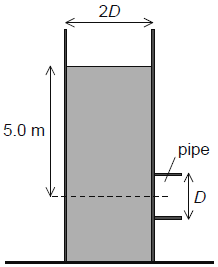 The ice cube melts.
Suggest what happens to the level of the water in the tube.
The ice cube melts.
Suggest what happens to the level of the water in the tube.
Outline why .
Question 2
HLPaper 3Gasoline of density 720 kg m flows in a pipe of constant diameter.

State one condition that must be satisfied for the Bernoulli equation to apply
Outline why the speed of the gasoline at X is the same as that at Y.
Calculate the difference in pressure between X and Y.
The diameter at Y is made smaller than that at X. Explain why the pressure difference between X and Y will increase.
Question 3
HLPaper 3A farmer is driving a vehicle across an uneven field in which there are undulations every 3.0 m.
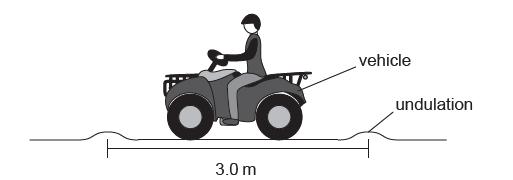
The farmer’s seat is mounted on a spring. The system, consisting of the mass of the farmer and the spring, has a natural frequency of vibration of 1.9 Hz.
Explain why it would be uncomfortable for the farmer to drive the vehicle at a speedof 5.6 m s-1.
Outline what change would be required to the value of for the mass-spring system in order for the drive to be more comfortable.
Question 4
HLPaper 3The diagram shows a simplified model of a Galilean thermometer. The thermometer consists of a sealed glass cylinder that contains ethanol, together with glass spheres. The spheres are filled with different volumes of coloured water. The mass of the glass can be neglected as well as any expansion of the glass through the temperature range experienced. Spheres have tags to identify the temperature. The mass of the tags can be neglected in all calculations.
Each sphere has a radius of 3.0 cm and the spheres, due to the different volumes of water in them, are of varying densities. As the temperature of the ethanol changes the individual spheres rise or fall, depending on their densities, compared with that of the ethanol.
The graph shows the variation with temperature of the density of ethanol.
Using the graph, determine the buoyancy force acting on a sphere when the ethanol is at a temperature of 25 °C.
When the ethanol is at a temperature of 25 °C, the 25 °C sphere is just at equilibrium. This sphere contains water of density 1080 kg m–3. Calculate the percentage of the sphere volume filled by water.
The room temperature slightly increases from 25 °C, causing the buoyancy force to decrease. For this change in temperature, the ethanol density decreases from 785.20 kg m to 785.16 kg m. The average viscosity of ethanol over the temperature range covered by the thermometer is 0.0011 Pa s. Estimate the steady velocity at which the 25 °C sphere falls.
Question 5
SLPaper 3Here's the correct conversion:
The diagram represents an ideal, monatomic gas that first undergoes a compression, then an increase in pressure.
A. adiabatic process then increases the volume of the gas to .
Calculate the work done during the compression.
Calculate the work done during the increase in pressure. a(ii).
Calculate the pressure following this process. b(i).
Outline how an approximate adiabatic change can be achieved. b(ii).
Question 6
SLPaper 3The first diagram shows a person standing on a turntable which can rotate freely. The person is stationary and holding a bicycle wheel. The wheel rotates anticlockwise when seen from above.
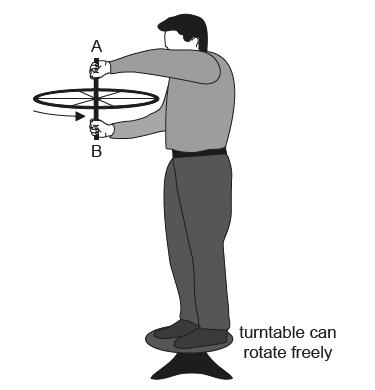
The wheel is flipped, as shown in the second diagram, so that it rotates clockwise when seen from above.
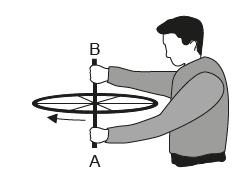
Explain the direction in which the person-turntable system starts to rotate.
Explain the changes to the rotational kinetic energy in the person-turntable system.
Question 7
HLPaper 3A ball is moving in still air, spinning clockwise about a horizontal axis through its centre. The diagram shows streamlines around the ball.
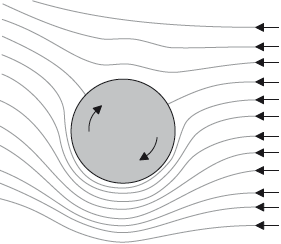
The surface area of the ball is m^2. The speed of air is 28.4 m/s under the ball and 16.6 m/s above the ball. The density of air is 1.20 kg/m.
Estimate the magnitude of the force on the ball, ignoring gravity.
On the diagram, draw an arrow to indicate the direction of this force.
State one assumption you made in your estimate in (a)(i).
Question 8
SLPaper 3A uniform rod of weight 36.0 N and length 5.00 m rests horizontally. The rod is pivoted at its left-hand end and is supported at a distance of 4.00 m from the frictionless pivot.

The support is suddenly removed and the rod begins to rotate clockwise about the pivot point. The moment of inertia of the rod about the pivot point is 30.6 kg m.
Calculate the force the support exerts on the rod.
Calculate, in rad s–2, the initial angular acceleration of the rod.
After time t the rod makes an angle θ with the horizontal. Outline why the equation cannot be used to find the time it takes θ to become (that is for the rod to become vertical for the first time).
At the instant the rod becomes verticalshow that the angular speed is .
At the instant the rod becomes vertical calculate the angular momentum of the rod.
Question 9
HLPaper 3An air bubble has a radius of 0.25 mm and is travelling upwards at its terminal speed in a liquid of viscosity Pa s.
The density of air is kg and the density of the liquid is kg .
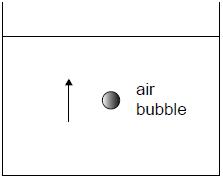
Explain the origin of the buoyancy force on the air bubble.
With reference to the ratio of weight to buoyancy force, show that the weight of the air bubble can be neglected in this situation.
Calculate the terminal speed.
Question 10
SLPaper 3Two of the brightest objects in the night sky are the planet Jupiter and the star Vega. The light observed from Jupiter has a similar brightness to that received from Vega.
Vega is found in the constellation Lyra. The stellar parallax angle of Vega is about 0.13 arc sec.
Identify the mechanism leading stars to produce the light they emit.
Outline why the light detected from Jupiter and Vega have a similar brightness, according to an observer on Earth.
Outline what is meant by a constellation.
Outline how the stellar parallax angle is measured.
Show that the distance to Vega from Earth is about .
